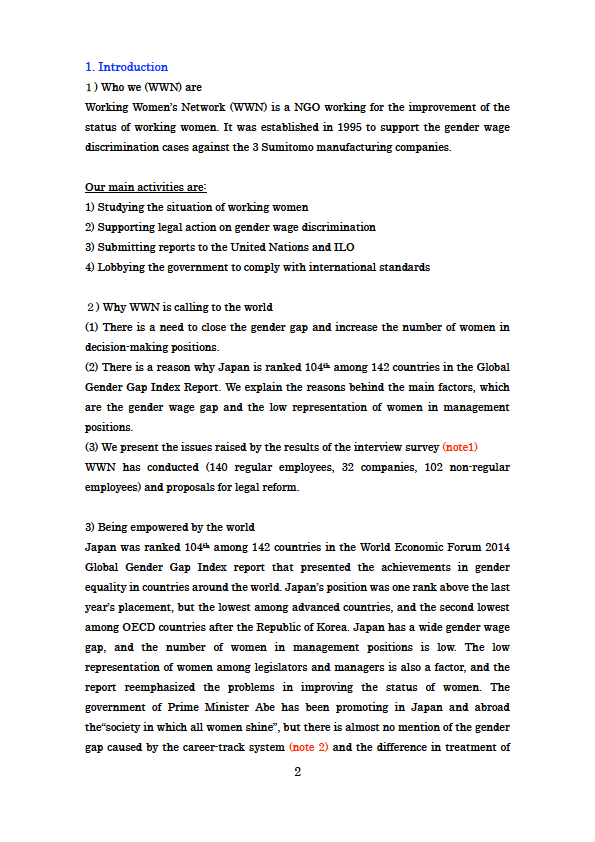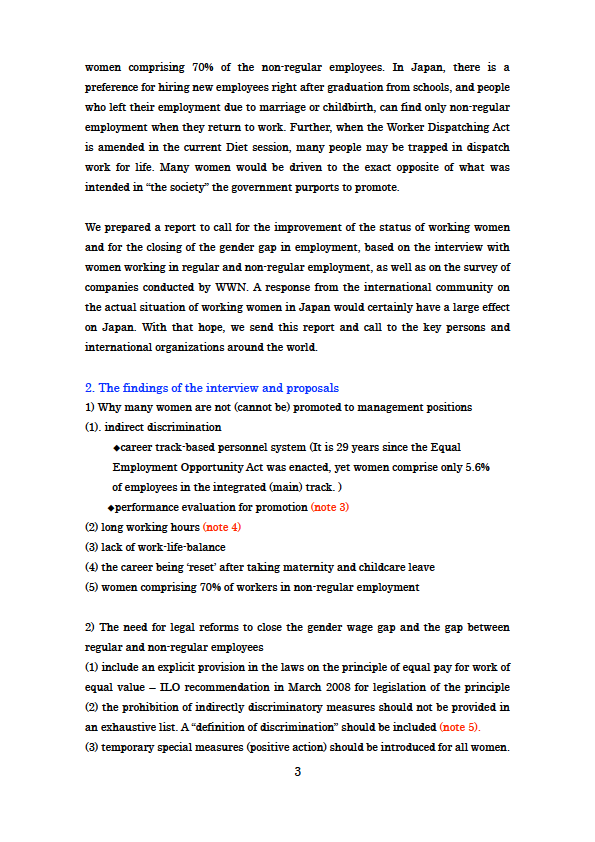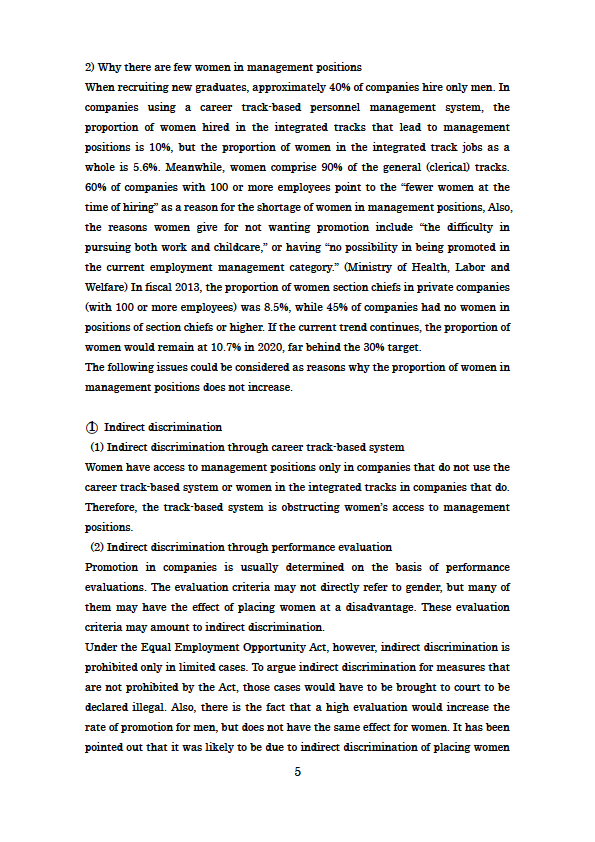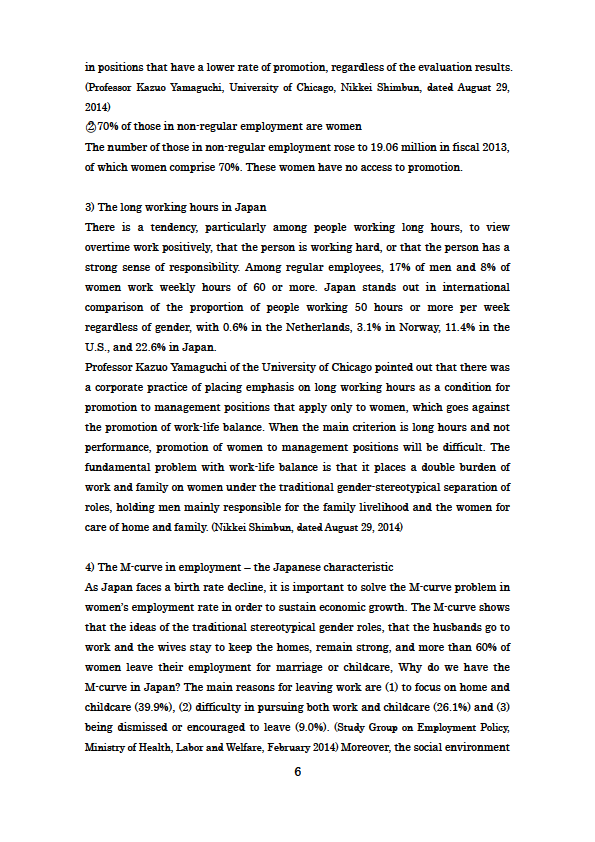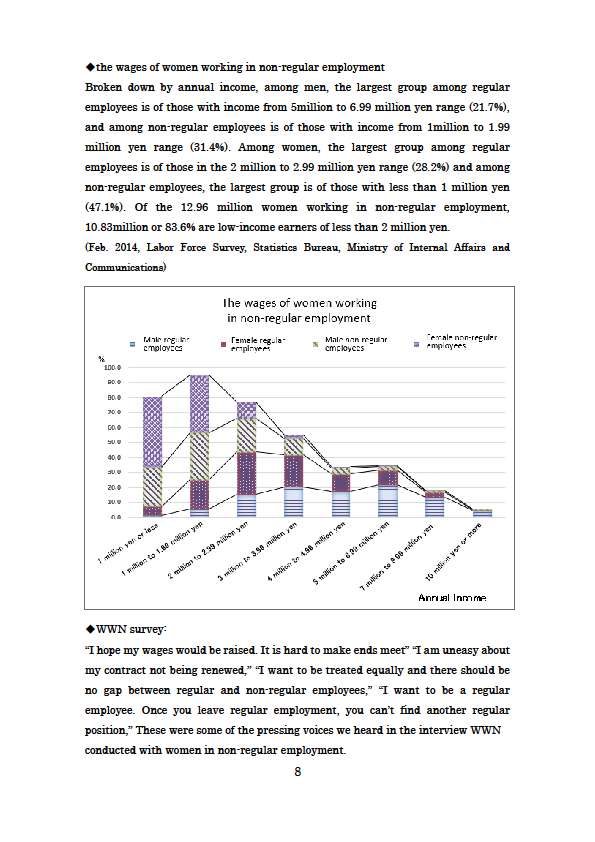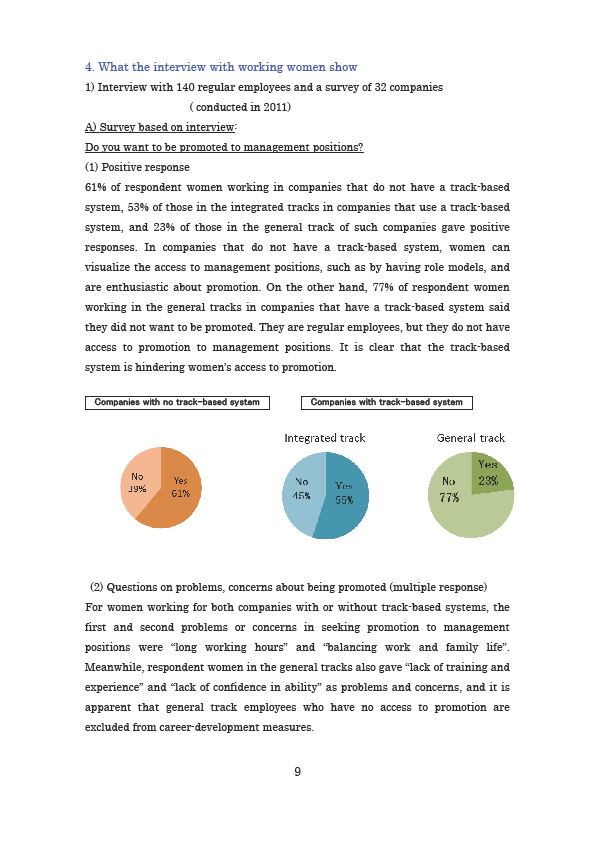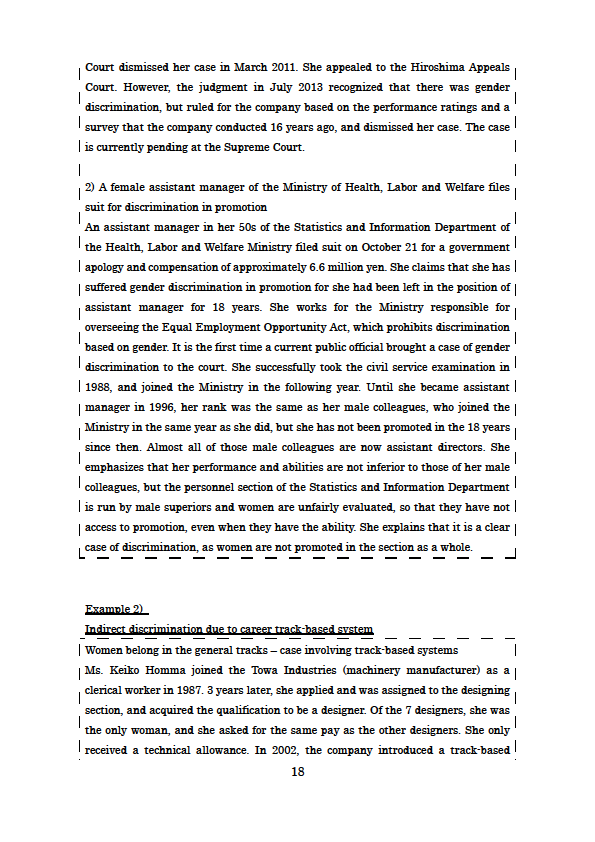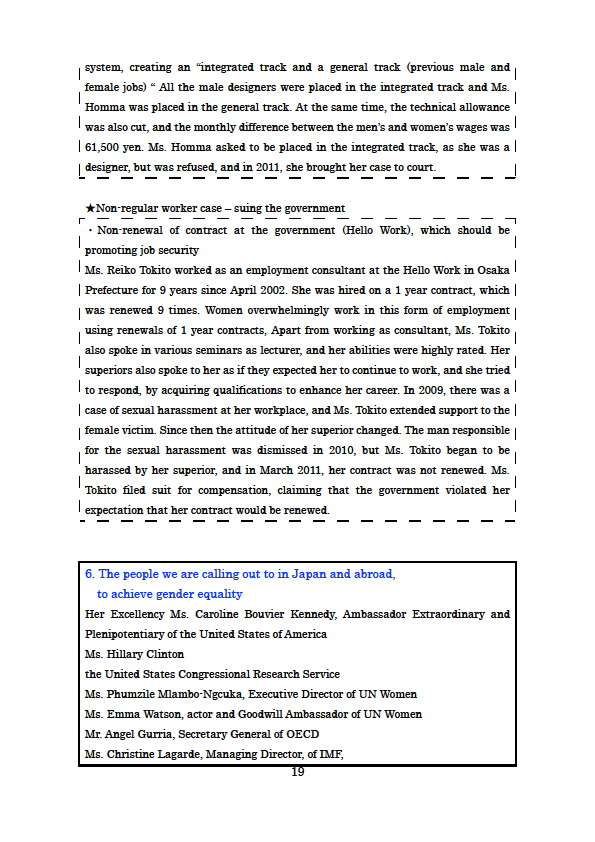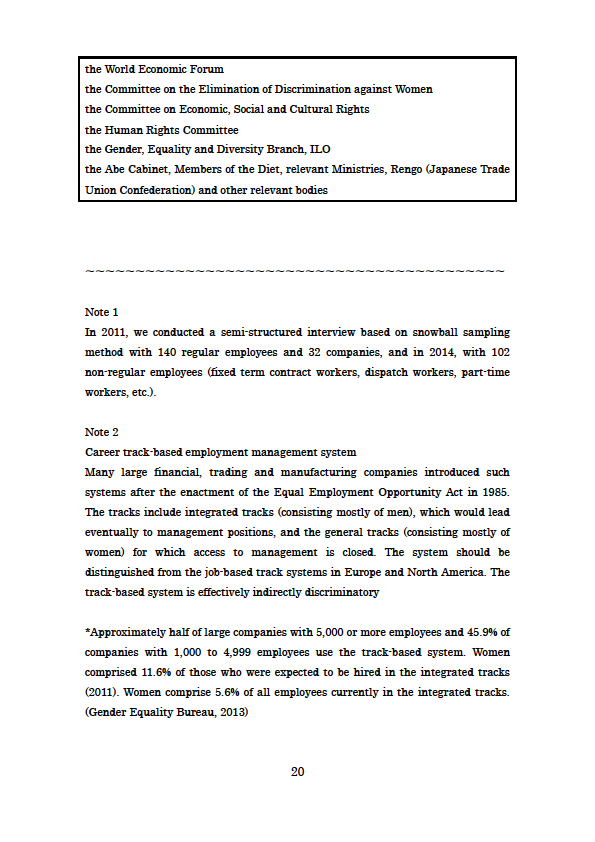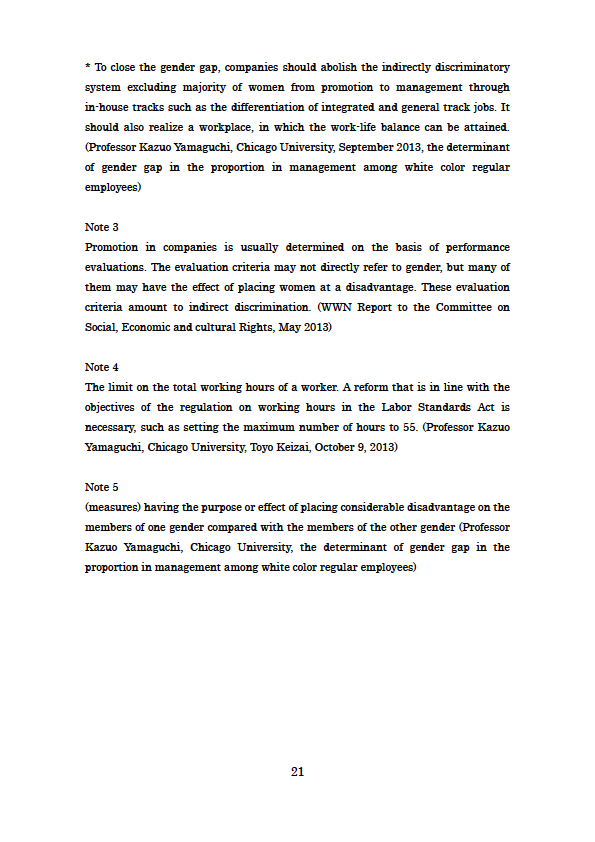WWN NEWS
WWN English News Dec. 1 2008
Working Women’s Network Lobbies the CEDAW in Geneva
Eleven members of WWN and other NGOs attended the CEDAW working group at United Nations in Geneva on Nov.10. We lobbied its members and submitted to them a report concerning the main reasons for indirect discrimination in order to allow the CEDAW to prepare questions for Japan based on the 6th Japanese government report.
Below is a summary of the questions WWN recommended to them.
Article 11 (Elimination of discrimination in the field of employment)
- “Employment Management Categories” in the Guidelines under the EEOL. Question: Doesn’t this practice ignore the CEDAW Recommendations and constitute indirect discrimination?
- The government states that Article 4 of the Labor Standards Act
encompasses the principle of equal pay for work of equal value, and
therefore the legislation of the principle as recommended by ILO is not
necessary.
Question: What legislative measures would be taken to implement CEDAW Article 11 (d) ?
These questions posed by the NGO might be helpful for the CEDAW membership.
On Nov 25, WWN found the CEDAW’s list of issues and questions to Japan on its web site. The Japanese government is supposed to send its answer to CEDAW in six weeks.
The CEDAW Working Group is very concerned about the Japanese women’s issue.
PDF・・・list of issues and questions
WWN is very happy that CEDAW asked the Japanese government to provide them with the guidelines under the revised EEOL which includes the indirect discriminations.
The government didn’t translate the guidelines, but one of WWN’s members – Ms Okada – translated it into English in the few days before we left Japan so we were able to take an English version with us.

At OECD on Nov.12 2008
We are concerned about the situation of non-regular workers in Japan, both in terms of working conditions and pay but also in terms of participation in training and, ultimately, their career prospects. The unfavorable conditions of non-regular workers are likely to worsen further over the coming months:at the time of economic downturn, like the one most OECD countries are facing at present, firms tend to dismiss non-regular workers first and this may add to the already difficult conditions of these workers.
WWN News No.19 Working Women’s Network visited ILO
Working Women’s Network visited ILO
and United Nations at Geneva in September,2007. WWN organized 26 women including Plaintiffs of Kanematsu , Sumitomo former plaintiffs , Lawyers and Professors,
In Japan, Still there are big wage gap between men and women. We made speech there we need the new low according to the convention of ILO 100 which mentions the equal pay for equal work value.
We built these issue at homepage as below. WWN’s report to ILO and Asahi News paper and Mainichi News paper which made article about our movement.
WWN’s Report to ILO, May 2007
Asahi Shinbun, Oct 26
Mainichi Shinbun Oct 29
WWN News No.18 A Huge Gift from CEDAW
Working Women’s Network
Shizuko Koedo, Manager, International Affair
CEDAW and the Equal Employment Opportunity Law
Japan signed the CEDAW in 1980, brought the domestic laws in line with the Convention, and adopted the Equal Employment Opportunity Law (EEOL). CEDAW was ratified in 1985. The EEOL, however, was not effective, as the companies merely had the responsibility of making the effort towards realizing equal opportunities. Moreover, the provision in the Guidelines under the EEOL, limiting the effect of equal treatment to within the hiring categories, provided the companies an excuse to introduce the career-track system, which amounted to “indirect discrimination.” The system resulted in all the men and just a handful of women being assigned to the tracks leading to management positions, and the rest of the women to the clerical track.
The Female Employees of Sumitomo Manufacturers Go to Court
In 1994, 9 women working for Sumitomo Electric Industries, Sumitomo Chemicals and Sumitomo Metal Industries applied for mediation under the EEOL to the Osaka Women and Young People’s Office, claiming a pay difference with male employees with the same educational backgrounds and years in employment. Except for the case of Sumitomo Metal, mediation was not initiated and the women brought their cases to court. The plaintiffs for the Sumitomo Electric also filed suit against the “state” for the non-initiation of mediation, claiming that it was an abuse of authority by the head of the Osaka Office.
WWN’s Strategy
Support for the Sumitomo cases led to the creation of the Working Women’s Network in 1995, with 200 members. Its purpose was to improve the status of women. Currently, it has 650 members, men comprising 10%. The main strategy of WWN is (1) to inform international organizations about the situation, including judicial cases, of working women in Japan, and to attract overseas support to put pressure on the government and employers, (2) to inform the general public through mass media, such as the newspapers and TV, and (3) to negotiate with the ministries, to call for the amendment of the EEOL so that it would be compatible with CEDAW.
The Huge Effect of CEDAW
Of particular note was the huge gift that the CEDAW recommendations in 2003 provided to the plaintiffs of the Sumitomo cases. In February of that year, the plaintiffs and members of WWN flew to New York to speak in the CEDAW pre-sessional working group, to provide materials and lobby the Committee members.
In July, we traveled again to New York, to be present during the CEDAW examination of the Japanese government report, and the Sumitomo plaintiffs spoke during the session. The members lobbied the CEDAW members again. The efforts were rewarded when the members’ questions to the government reflected the situations we faced.
In December, the judge in the Sumitomo Electric case referred to the CEDAW recommendations issued in August in his recommendation for a settlement, pointing to the steady progress towards realization of equality between men and women in the international society, led by the UN. The Sumitomo Electric case reached settlement, and the two plaintiffs were promoted to management positions. The trend continued and the Sumitomo Chemical case in the following year, as well as the Sumitomo Metal case in April 2006, concluded in considerably favorable settlement for the plaintiffs.
Indirect Discrimination Included in the EEOL Amendment
The CEDAW recommendation, calling for an explicit inclusion of indirect discrimination in domestic law, proved to be another gift for us. WWN started lobbying Diet (parliament) members, and the Ministry of Health, Labour and Welfare using the document. After a year and half of lobbying and organizing meetings with Diet members, the amended EEOL went into force since April 2007.
For the first time in Japan, indirect discrimination was explicitly prohibited, although on a limited basis. WWN is working towards the next amendment of the EEOL, to increase the scope of the indirect discrimination and to realize equal treatment, for the purpose of the legislation of the principle of equal pay for work of equal value.
WWN News No.17 Sumitomo Metal Wage Discrimination Case
– the Significance of the Victorious Settlement
June 18, 2006, Lawyer Mitsuko Miyachi
The court cases against the three Sumitomo manufacturers were made possible by the determination of the plaintiffs, their supporters, which led to the creation of the Working Women’s Network (WWN), and expectations of the many people drawn to the cause. The series of cases was concluded with a spectacular win in the Sumitomo Metal case. It goes without saying that the victory would not have been possible without the selfless efforts of the plaintiffs and their team of lawyers. At the same time, however, in this case, the analysis of the defeat of the Sumitomo Electric and Sumitomo Chemical cases in the district courts provided an important key. In that sense, the victory is the outcome of having challenged the three companies together. The following is a review of the characteristics of the Sumitomo Metals case compared with the other two.
1. Difference in the System
The structure of discrimination between men and women in the three Sumitomo companies shares the same basis. At the starting point, there is discrimination in the work. The companies’ claims that the hiring categories are different are also the same. There was a difference, however, between Sumitomo Metal and the other two cases, in whether the differences in hiring categories were explicitly set forth in the system. Both in Sumitomo Electric and Sumitomo Chemical, the men hired in the head office category and the women hired in the branch office category were placed in different job classifications within the system (except in the case of Sumitomo Electric, where men and women high school graduates hired between 1968 and 1977, were placed in the same job classifications.). In Sumitomo Metal on the other hand, both men hired in the head office category and women hired in the branch office category were placed in the same “clerical technical job.”
2. Obtaining Internal Personnel Material
Another factor that worked in our favour in the Sumitomo Metal case, was the information on internal materials on personnel that was provided to us. In July 1998, the lawyers acting on this information, applied for an order to produce the internal documents on personnel matters. But the application was denied in September 1999, and the lawyers had to be content to submitting the documents that was provided to them as evidence. These internal documents helped in showing that at Sumitomo Metal, the personnel system separated the employees into 5 categories (U, HTK, BH, LC, general) and their evaluations, as well as pay grades were determined accordingly. Women were designated in the general category, whose evaluation levels were at the lowest, therefore their pay and other grades were also kept at the lowest levels.
3. What We Learned from the District Court’s Sumitomo Electric Decision
The District Court handed down the decision on the Sumitomo Electric case on July 31, 2000. The decision compared the women in clerical jobs with blue-collar male employees, and finding little difference, denied the existence of a gender-based labour management. The lawyers of the Sumitomo Metal case learned from this defeat, and decided to change to strategy to clarifying the situation of blue-collar male high-school graduate employees who transferred to clerical jobs (BH, LC). They applied for an order to produce the pay ledger of high-school graduates in the BH, LC category. As a result, the company produced the ledger for 837 employees. On careful analysis of the documents, we discovered that there was a ledger that the company had not produced. When questioned, it submitted the ledger for a further 312 employees. After analyzing these ledgers thoroughly, in the period 1994-1995, comparing the plaintiffs and the men in BH category, there was a 3.01million to 1.26 million yen pay difference annually, and in comparison with men in the LC category, a 2.02million to0.71million yen difference.
4. Application to Remove a Judge
On March 28, 2001, the District Court decided to dismiss the plaintiffs’ claims in the Sumitomo Chemical case. The framework of the opinion, finding that the gender-based hiring was not against public order and good morals of the time the plaintiffs were hired, was the same as the Sumitomo Electric decision. After having received two dismissals from Judge T. Matsumoto, of the 5th Civil Section, we applied on April 1, 2001, for the removal of the judge due to his gender bias. Because of the application, the trial was interrupted until end of January 2002. In end March 2002, there were personnel changes, Judge Matsumoto transferred to another court, and Judge Osada came in his place. The removal application had effectively served its purpose.
5. District Court Decision
The District Court decision on March 28, 2005, following the above events, recognized the unlawfulness of the discriminatory treatment in promotion and pay between high-school graduate men and women, even when their capabilities were evaluated as being the same. This was the result of the evaluation and grading systems, which was shown in the internal personnel documents. The court ordered the company to compensate for the difference in pay compared with a male LC transferee. The amount was 11.374 million to 18.85 million each, (total 63.112 million yen). The company appealed.
6. Appeal Court Trials and the Settlement Recommendation by Judge Igaki
The case was sent to the 14th Civil Section of the Appeals Court presided by Judge Igaki. Under him, the Sumitomo Electric case concluded on December 24, 2006, with a settlement, whose terms included the plaintiffs’ promotion. His grasp of the issue was apparent in the Sumitomo Metal case as well, and refusing the employer’s application for witnesses, by the beginning of April 2006, recommended a settlement proposal. The company could not refuse the proposal based on the amounts recognized in the first instance, but appropriately including the results of the appeals trial process. And on April 25, 2006, a settlement was reached with the agreement to pay the plaintiffs a total of 76 million yen and to pay due consideration in their treatment in the future.
During this time, the Diet was deliberating the amendment to the Equal Employment Opportunity Law, particularly on the issue of the prohibition of indirect discrimination. The recommendation of the settlement pointed out that while a gender neutral system appears to have been put into place, the gap between men and women have not been appropriately addressed in reality. It warned that, “proper note should be taken that the delay in transforming the awareness, may provide the breeding grounds for new discrimination (indirect discrimination and increase in non-regular employment, particularly for women).” The victorious settlement was possible because we stood up to challenge the system. And the recommendation by Judge Igaki is also our valuable asset.
*****
On May 22, 2006, Nippon Keizai Shimbun published an article about the
discrimination lawsuits against three Sumitomo employees. A extract from
that article appears below.
*****
What Discrimination Lawsuits against Three Sumitomo Companies Brought Challenging “Indirect Discrimination”
:Ten-Year Battle, Victorious Settlement
A series of discrimination lawsuits against Sumitomo Electrics, Sumitomo
Chemicals, and Sumitomo Metals recently ended when the last one brought
against Sumitomo Metals was settled out of court. What results did these cases after ten years of court battle bring?
“When you bring a lawsuit against someone, you are working in the dark. I didn’t think in my wildest dream that a victorious settlement was waiting at the end of the tunnel” says attorney Miyaji Mitsuko who handled the three Sumitomo cases.
In August, 1995, nine women working for the three Sumitomo corporations filed lawsuits with Osaka District Court, demanding the elimination of the discrepancy in treatment and wage between male and female employees.
While men with the same educational credentials and tenure assumed important positions in the company and were promoted accordingly, women remained where they started. “It has already been thirty years. The wage difference between men at the section chief level and us is 240,000 yen. We deserve the same opportunity” claimed the women. The employers responded by claiming, “we are talking about different career tracks” and “there is a system in place to allow transfers between the tracks,” and denied the existence of discrimination.
*****
The women lost in July, 2000 against Sumitomo Electrics, and in March, 2001 against Sumitomo Chemicals and then appealed. In the case of Sumitomo Metals, the “hidden system of personnel management” caught much attention and Osaka District Court ordered the defendant to pay 63,000,000 yen to each of the four plaintiffs. Sumitomo appealed and the second stage of the battle took place at Osaka Appeals Court.
A victorious settlement came in December, 2003. Sumitomo Electrics promoted the two plaintiffs and paid each 5,000,000 yen. In April of this year, the Sumitomo Metals case reached a settlement in which the defendant was to pay 76,000,000 yen to the plaintiffs, more than what the first judge ordered. In both cases, the settlements were a large compromise for the defendants and the women call the settlements “victorious.”
Koedo Shizuko from Working Women’s Network, a group who supported the Sumitomo plaintiffs, told the reporter, “We can attribute the victory partly to our efforts in working with the United Nations Committee on the Elimination of Discrimination against Women and applying external pressure.”
*****
Osaka Appeals Court stated in its recommendation to settle the Sumitomo Metals case that: “even though it appears as though the past personnel management system was corrected and a gender-neutral system was put in, it is still difficult to say that the inequality between men and women was eliminated”; “we need to give much consideration to the issue so that outdated beliefs will not lead to new forms of discrimination such as indirect discrimination and increase in contingent jobs.”
The Sumitomo cases that lasted for ten years demanded a reconciliation of the past and now are challenging us to consider what to do about new forms of discrimination.
WWIN News NO.16 Asahi Simbun June 16, 2006
Amended Equal Opportunity Law Passes Transfers and Body Size… “Indirect Discrimination” Prohibited, Sexual Harassment of Men Included
By Takenobu Mieko
The amended Equal Employment Opportunity Law was voted unanimously on the 15th in the Lower House, finalizing the legislation of the amendment. The amendment includes prohibition of “indirect discrimination” – when certain criteria seem gender-neutral and yet in effect brings about disadvantage to one sex – as well as obligates employers to prevent sexual harassment of both women and men. Looking towards the implementation in next April, details of the guideline and the ministerial statute are scheduled to be worked out.
As for indirect discrimination, the representatives of employers showed reluctance to include it for the reason that “the concept has not widely taken root and would cause much confusion.” Consequently, the amendment came to list three forms of indirect discrimination in the ministerial statute (1. height, weight, and strength requirements in recruitment and hiring, 2. requirement of nation-wide transfers in recruitment and hiring for managerial-track positions, 3. requirement of geographical transfers in promotion).
However, after receiving criticisms such as “many will think that listing three forms will excuse other forms” and “legislating this way will not deal with changing forms of discrimination,” the government attached a note to the law stating that there could be other forms of indirect discrimination and that the court may find more than those listed in the statute. The law also includes a new stipulation that the next amendment is to be made within five years if necessary.
Moreover, the definition of sexual discrimination was expanded to include discrimination against men. With this, employers are obligated to institute programs to prevent sexual harassment of men and are prohibited to exclude qualified men for jobs such as nursing and clerical work. The employer’s obligation of instituting sexual harassment prevention programs was made stronger with this amendment.
The amended law also prohibits unfavorable treatment such as demoting the worker from full-time to part-time status and not renewing the worker’s contract on the grounds of pregnancy and taking advantage of maternity leave. Currently, the law merely prohibits dismissal on the grounds of pregnancy and/or child birth. Under the new amendment, dismissal during pregnancy or within one year after giving birth is invalid.
Focus on Helping Working Women
Elimination of Other Forms of Discrimination is the Key
************************************
< Editor’s Note>
From “Just like men” to “Improved work conditions for women”… This amendment had to consider the low birth rate, increasing competition in the global market, and the international push behind allowing women to more effectively use their abilities and skills— it intended to make a shift in the debate about the contents of equality.
The most important issue then is prohibition of indirect discrimination. Although it lists only three forms, the prohibition of geographical transfers as a requirement in hiring for managerial-track positions and in promotion should call into question the established worker model as a man with little family responsibility.
However, the amendment is only half way there. In Western nations, indirect discrimination is “by principle prohibited and is dealt with by building cases after cases.” With only three forms of indirect discrimination listed in the new amendment, there is much anxiety over its implications for future court cases that might be deemed outside the stipulation of the law and thus lead to unfair judgments.
Thus, the law acknowledges that “the court may find more than those listed in the statute” and states that “another amendment is to be considered before five years pass.” Japanese Trade Union Confederation and women’s organizations give partial credit to the results and are planning to dig up various cases of indirect discrimination in order to facilitate the next step. Actions like these are essential to making effective legislation for the elimination of discrimination.
WWIN News NO.15 Asahi Shimbun, May 16 2006
Can “Indirect Discrimination” be Regulated?
– Draft Bill for the Amendment of the Equal Employment Opportunity Law deliberated in the Diet
– Concerns over “Exhaustive List”
– The Practice Prohibited in Principle in Europe and in the U.S.
It is likely that a “prohibition of indirect discrimination” will be included in the Equal Employment Opportunity Law. It provides for the prohibition of practices and standards that lead to sex discrimination in effect, even when the discrimination is not directly based on sex. The draft amendment bill passed the House of Councilors at the end of last month, and currently awaits deliberation in the House of Representatives. The provision is well established in Europe and the U.S., but the noticeable aspect of the current draft provision is that it limits the indirect discrimination to three cases. Concerns have been voiced, that anything other than what has been listed would not be regulated, raising questions about its effectiveness.
Mieko Takenobu, Tomoko Adachi
On the 26th last month, Ms. Katsumi Nishimura (58), a Sumitomo Electric Industries employee requested to speak before the House of Councilors Committee on Labour, emphasized, “I felt my dignity as a human being was being deeply hurt, seeing a male colleague, who was so young he could have been my son, being able to develop his capabilities by the work he was given. I would like to see indirect discrimination banned.”
Ms. Nishimura filed suit in 1995 against her employer claiming damages for wage discrimination. Although she worked for approximately 30 years with no promotion, male employees who were hired at the same time she was reached management positions and the wage gap widened to 240,000 yen a month. After being told that, “the difference was not discrimination but the difference in career tracks,” she decided to go to court, but lost in the first instance. She agreed to settle at the appeals level, the terms of which included promotion.
Indirect discrimination occurs when a practice or standard is apparently neutral, but is disadvantageous to either women or men in effect. Explicit discrimination was banned under the 1985 Equal Employment Opportunity Law, but companies increasingly adopted the “career track-system,” in which men and women were placed in tracks and given different treatment in pay raise and promotion, or hired women as part-time workers to do the same work as regular employees. Lawsuits against such “discrimination” were filed one after the other in the 1990’s. Ms. Nishimura’s is one of them. The UN CEDAW has repeatedly recommended to the Japanese government for improvement. These were factors behind the inclusion of the indirect discrimination ban in the draft bill.
The current problem is the fact that the draft adopted the “exhaustive list” in limiting the application of the law of indirect discrimination to those set forth in the bill. According to Professor Mutsuko Asakura of the Waseda University, Graduate School, a labour law expert, indirect discrimination is prohibited in principle in the EU countries and the U.S., and decided according to the circumstances of each case. In the U.K., placing women raising children in late night or early morning shifts, or agreements to dismiss part-time workers first were found to be indirect discrimination.
In Japan, the employers’ side resisted to the introduction of the indirect discrimination ban, saying that they did not know how far it would broad the law will be applied. As a compromise, out of the 7 cases raised in the Ministry of Health, Labour and Welfare Study Group in 2004 (see box), 3 cases such as the height and weight requirement in recruitment and hiring would be identified by the ministerial order as indirect discrimination coming under administrative guidance.
Agreement on Revision after 5 years
In the discussions in the House of Councilors, the 3 opposition parties, the Democratic Party, Communist Party and the Social Democratic Party, argued for a revision of the exhaustive list system.
Statements against the draft provision continued, such as, “What happens if sexual harassment was limited to 3 cases? If suggesting going to a hotel, touching someone’s breasts, and putting up a poster of a nude figure were identified as sexual harassment, then all other forms of sexual harassment would not be prohibited and the law would be meaningless.” (Ms. Fukushima, Leader of the Social Democratic Party)
After agreeing to include in the additional provisions, a clause to review the law after 5 years, as well as adopting a decision stating that, “there are indirect discrimination other than those identified by the ministerial order,” the 3 opposition parties in the end voted for the bill.
Ms. Yoriko Kawaguchi, Member of the House of Councilors and Chair of the Special Committee on Women of the Liberal Democratic Party, spoke positively of the vote, “Almost no one knows about indirect discrimination. The inclusion of the concept in the bill will lead to publicizing it, and would be a step forward.” Ms. Yoriko Madoka, Member of the House of Councilors from the Democratic Party says, “We chose to move at least a step forward in the face of the uncompromising attitude of companies and the majority of the government parties.”
Outside of the Diet, moves to raise awareness on indirect discrimination are increasing in the private sector. “Equal – Human Rights Center for Working Women” set up an “indirect discrimination hot-line” in March. Working Women’s Network (WWN)” also published a Japanese- English DVD on experiences of women who were indirectly discriminated against, to publicize “discrimination in everyday life.”
Cases of Indirect Discrimination Raised by the Ministry of Health, Labour and Welfare Study Group Report
3 cases in the exhaustive list
Height/weight
Requiring certain height or weight in recruitment and hiring, even when it is not necessary to the work, placing many of the women at a disadvantage.
Country-wide mobility
Requiring country-wide mobility for recruitment and hiring in management tracks, even when there are no reasonable grounds, such as transfers are necessary for management positions, placing many of the women at a disadvantage.
Transfer experience
Requiring past experiences of transfers involving changes of residence, even when it is not related to the work, placing many of the women at a disadvantage.
Other cases
Academic background
Requiring certain academic background including degrees in certain faculties, even when it is not necessary to the work, placing many of the women at a disadvantage.
Head of family
Requiring recipients of welfare and family benefits to be heads of family, even when there are no limits placed on the employers’ capital, or place undue burden on the employer, placing women at a disadvantage.
Regular employee priority
Giving preferential treatment to regular employees, even when there are no differences in work content between regular and part-time employees, placing many of the women at a disadvantage.
Welfare benefits
Excluding part-time employees from welfare and family benefits, even when there are no differences in work content, placing many of the women at a disadvantage
WWIN News NO.14 NOV.3.2003
WWIN invited Dr Hanna Beate Schopp-Schilling who is the Member of CEDAW since
the end of Sept to Oct 5th.
She gave us her lecture especially about “The Indirect Discrimination” and “The
Optional Protocol” at Osaka,Fukuoka and Tokyo .
About 550 audiences gathered there and they were encouraged by her lecture.
Several newspapers had the report on her lecture .
We introduce you one of the article which News Paper is Nikkei as follow.
************************************
Sept.28th at Osaka
Interview with Dr. Schoepp-Schilling, Member of the UN Committee on Elimination of All Forms of Discrimination against Women
Nikkei Shimbun, 8 Oct. 2003, p. 14, evening edition
Clear Definition of Indirect Discrimination Needed
Track-based Personnel Management within Convention Scope
Child-care Leave for Men Also Necessary
Dr. Schoepp-Schilling, the German Member of UN CEDAW and an expert on global trends in women’s labour issues, was invited to Japan by NGOs.
The CEDAW monitors the situation of State Parties to the Convention on the Elimination of All Forms of Discrimination against Women. Recommendations were sent to the Japanese Government this August. Nikkei Shimbun interviewed Dr. Schoepp-Schilling, who has earlier served as the Director on Women in the Federal Ministry of Health and Welfare, on the recommendation and other issues.
Q: How do you see the situation regarding women’s labour in Japan?
“My comments will be personal and not made as a CEDAW member. The Japanese Government admits in its 5th Report to the CEDAW submitted in 2002, that women do not enjoy a stable status in the labour market. Many women work part-time, or as dispatch workers.”
“In many cases, women bear the burden of both work and home, so many women in the rest of the world also want to work part-time. But the situation itself, in which there is no other option except part-time work, is discriminatory and undesirable. Many countries in the EU have legislation prohibiting discrimination against part-time workers in pay and treatment. I would like to see the Japanese Government take legislative measures to prohibit discrimination against part-time workers. And in that case, the prohibition should be not just for pay but should cover maternity and child-care leave, and should prohibit discrepancies in treatment compared with regular workers.”
Q: CEDAW recommended that Japan should take steps against indirect discrimination. Unlike direct discrimination, which limits promotion and recruitment on grounds of being a woman, indirect discrimination is not known in Japan.
“Indirect discrimination is discrimination, in which a law, regulation, provision or practice is neutral at first glance, but has a negative impact on either one of the sexes. In the U.S. for example, there used to be certain height and weight requirement in the hiring standards for the police. But in general, women were shorter and weighed less, and not many were hired. The court then ruled that weight and height requirement was indirect discrimination, and that the police should assess individual aptitude and abilities instead, which lead to the change in provisions which were disadvantageous for women.”
“There are cases in Europe as well. In a department store in Germany, treatment for part-time workers was less favourable than that of full-time workers. The majority of full-time workers were men, while the majority of part-time workers were women, and the part-time women were not even given the opportunity to transfer to full-time work. Therefore, the court decided that the situation amounted to indirect discrimination.”
“Japan should clearly define what constitutes indirect discrimination, not just in labour laws, but also in general laws, such as the civil code. If the definition is not clear, the labour courts will not have a standard to assess the cases.”
Q: In Japan, we have track-based personnel system, in which employees are categorized in tracks for mainstay positions and for assistant positions, and the latter consists mostly of women.
“The Japanese Government did not provide us with the English translation of the Guidelines for implementing the Equal Employment Opportunity Law, so we had to rely on the NGO information regarding track-based personnel management. Accurate assessment is therefore difficult. But if the understanding is correct that, the Equal Employment Opportunity Law prohibits sex discrimination only within the same employment management category, and does not cover discrimination among different categories, such as management position tracks and assistant position tracks, the situation, in which the former is mostly men and the latter mostly women, is likely to be indirect discrimination.”
“I have heard that the Japanese Government is currently having the equal employment opportunity policy study group study the definition of indirect discrimination, including cases in other countries. I hope that through studies on cases in other countries, they would reflect on the Japanese situation, to see whether it amounts to indirect discrimination.”
Q: While calling for the elimination of sex discrimination on the one hand, there is a strong opposition among women to being drawn into the long-hour labour.
“The Convention provides that maternity is a social function, and child rearing and education is a responsibility borne by both women and men. I think the ideal society is one where young parents are both given the opportunity both at work and at home. For example, in Sweden and Germany, parents can not only take child-care leave, but they are guaranteed to return to their former jobs. In Sweden, income security during leave is also being secured through parent insurance.”
“The key to realizing a desirable society would be not just taking legal measures, but to think of creating an environment in which men can take child-care leave. In Sweden, some companies have a system, in which bonus points are awarded in their assessment evaluation, when employees take child-care leave. On the other hand, Germany has a requirement to increase the ratio of women in management position in the civil service. These measures will provide some reference.”
Chart: UN CEDAW Concluding Comments (main points regarding Japanese labour)
*Recommends that a definition of discrimination against women, encompassing both direct and indirect discrimination be included in the domestic legislation.
*Expresses concern at the high percentage of women in part-time and dispatch work, whose salaries are lower than those working in a regular situation.
*Urges that the Guidelines to the Equal Employment Opportunity Law be amended, and efforts increased towards promoting the achievement of de facto equality between men and women in the labour market.
*Recommends that efforts be made to eliminate horizontal, segregation such as by job classifications and forms of employment as well as vertical segregation such as by promotion, through education, training and systematic monitoring.
WWIN News NO.13 Sept.7.2003
TO
The CEDAW Council
For Japanes government
2003.July.8th
NGO Report by Working Women’s International Network
Japanese Corporations and Government Should Establish Equal Pay
for Men and Women without Delay
We are an organization of the plaintiffs and their supporters, pursuing court cases against Sumitomo Electric, Sumitomo Chemicals, Sumitomo Metal and the Japanese government for wage discrimination based on sex. We came to make an appeal to you on the occasion of the examination of the Japanese government report on equality between men and women on July 8th, 2003 at the United Nations Committee on the Elimination of Discrimination against Women (CEDAW).
In Japan, which is supposed to be one of the “economic giants,” even women like us, working as regular employees earn only 65% of the male employees’ wages. But half of the working women are in part-time jobs (90% of people working part-time jobs are women), and their wages make up a mere 40% of those of men. The right to equality in work has yet to be established in Japan. The details of our arguments can be found in the NGO Report, but in short, our wish is to realize the following four conditions.
1. Prohibition of indirect discrimination
In the previous examination of the Japanese Report (1994), the government was requested to “… report on the measures taken to address the indirect discrimination faced by women..” in the Concluding Observations. The government, however, has not taken any measures, and in the current Sumitomo Electric and Sumitomo Chemicals cases, the gender based employment management apparently resulted in a wage difference of 2,000 dollars a month between high school graduate women and men with similar years in employment. The Osaka District Court admits to the existence of this difference. But both government and the companies argued that the reason for the difference is the different hiring categories. Men were hired as prospective management personnel, while women were hired to take on routine assistant work. The difference, they explained, was the result of different career tracks, and not based on sex. The Osaka District Court decisions sided with those arguments.
The Japanese career track-based hiring is a cover for sex discrimination. (This has been mentioned at the ILO 91st General Meeting in 2003.) To promote equality between men and women in Japan, there should be an explicit prohibition against indirect discrimination. Nine years has passed since the last CEDAW recommendations, and the Government still continues to state that they are “studying” the issue of indirect discrimination, and has not implemented the Convention without delay. The Government should fulfill its responsibilities.
2. Revision of the Guidelines for the Equal Employment Opportunity Law
CEDAW questioned why discrimination persisted even after the enactment of the Equal Employment Opportunity Law. The answer lies in the fact, that the Guideline provides a loophole for companies. The Guideline states that comparison would not be made if the employment management categories are different. Because of this Guideline, discrimination between men and women is kept ingeniously hidden, and the companies would be able to continue discrimination by changing these categories, such as branch-based hiring or hiring for part-time positions. The Guideline is in violation of the Convention against All Forms of Discrimination against Women, and should be revised immediately.
3. Elimination of discrimination without delay
Discrimination in wages and promotion still continue by reason of gender-based hiring before the entry into force of the Convention. The Court denied any remedies for the plaintiffs, by saying that there was no responsibility to correct the discrimination, since the plaintiffs were hired before the enactment of the Equal Employment Opportunity Law, and the Law was not retroactive. If the spirit of the Convention was to be adhered to, the continuing discrimination should be eliminated without delay.
4.The ratification of the Optional Protocol to the Convention by Japanese government soon.
The court cases are facing an important phase this year. We ask for your kind support.
E-mail : WWIN@mv.email.ne.jp
URL: http://www.ne.jp/asahi/wwn/wwin
CEDAW/C/2003/II/CRP.3/Add.1/Rev.1
ADVANCE UNEDITED COPY 18 July 2003
Committee on the Elimination of
Discrimination against Women
Twenty-ninth session 30 June -18 July 2003
Draft report
Consideration of reports of States parties
Japan
Fourth and fifth periodic reports
1. The Committee considered the fourth and fifth periodic reports of Japan
(CEDAW/C/JPN/4 and CEDAW/C/JPN/5) at its 617th and 618th meetings on 8 July 2003.
I. Introduction by the State party
2. In introducing the fourth and fifth periodic reports, the r epresentative
emphasized that great progress had been made for gender equality in the 1990s.
Information, including the opinions of non-governmental organizations, had beensought in the preparation of the present reports. As national government ministries and agencies had been streamlined in 2001, the existing national machinery forgender equality had been strengthened. The Gender Equality Bureau had beenestablished within the Cabinet Office, with responsibility for planning andcoordinating the gender equality policies of the Government. The Council forGender Equality, chaired by the Chief Cabinet Secretary, who also held the post of Minister of State for Gender Equality, consisted of ministers and experts, and monitored the implementation of gender equality policies and studied their effects.
3. The representative drew attention to a number of new legal and othermeasures. The Basic Law for a Gender-equal Society had been enacted in 1999,followed by the adoption in December 2000 of the Basic Plan for Gender Equality.
II. Concluding comments of the Committee
Introduction
12. The Committee commends the State party for t he quality and timely submission of its fourth and fifth periodic reports, which comply with the Committee’s guidelines for the preparation of periodic reports. It expresses appreciation to the State party for the written replies to the issues and question s of
the Committee’s pre -session working group and for the comprehensive oral presentation, which provided additional information on recent developments in the State party.
Principal areas of concern and recommendations
21. The Committee expresses concern that, while the Constitution stipulates equality between the sexes, no specific definition of discrimination has been included in domestic legislation.
22. The Committee recommends that a definition of discrimination against women encompassing both direct and indirect discrimination, in line with article 1 of the Convention, be included in domestic legislation. It also recommends campaigns to raise awareness about the Convention, in particular the meaning and scope of indirect discrimination, aimed, inter alia, at parliamentarians, the judiciary and the legal profession in general.
23. While appreciating the State party’s recognition that the long –standing stereotyped perception of gender roles remains the major obstacle to achieving equality between women and men and noting its efforts based on regular opinion polls in this regard, the Committee remains concerned about the persistence of deeply rooted and rigid stereotypes in Japan regarding the role and responsibilities of women and men in the family and in society, which are reflected in women’s situation in the labour market, educational choices and low participation in political and public life.
33. The Committee is concerned at the existing wage gap between women andmen, stemming largely from the difference in type of work, horizontal and vertical employment segregation as expressed by the two -track employment management system, and the lack of understanding regarding the practice and the effects of indirect discrimination as expressed in the governmental guidelines to the Equal Employment Opportunity Law. The Committee is further concerned by the high percentage of women in part -time work and by women who are “dispatch workers”, whose salaries are lower than those working in a regular situation. The Committee is deeply concerned about the difficulties faced primarily by women in reconciling their personal and family lives with professional and public responsibilities.
34. The Committee urges the State party to amend its guidelines to the Equal Employment Opportunity Law and to increase its efforts towards accelerating the achievement of de facto equal opportunities for women and men in the labour market through, inter alia, the use of temporary special measures in accordance with article 4, paragraph 1, of the Convention. The Committee
recommends that efforts be made to eliminate occupational segregation, both horizontal and vertical, through, inter alia, education and training, effective enforcement mechanisms and systematic monitoring of progress. TheCommittee recommends that measures allowing for the reconciliation of family and professional responsibilities be intensified, that equal sharing of domestic and family tasks between women and men be promoted, and that changes to the stereotypical expectations of women’s roles in the family and labour market be encouraged.
39. The Committee encourages the State party to continue to consider the ratification of the Optional Protocol to the Convention, while noting the concerns expressed by the State party in its fifth periodic report. The Committee strongly believes that the mechanisms available under the Optional
Protocol would strengthen the independence of the judiciary and assist it in understanding discrimination against women.
*** WWIN cut the part of this Draft report. IF you want to see all artcle. Please let us know.***
Asahi News Paper : Aug. 10, 2003
“Track-based Employment Criticized” (Osaka title)
(Tokyo title, “Overwhelming number of women in general clerical jobs –
should be defined as discrimination in law”)
“Indirect Discrimination” subject of UN Recommendation
Equality between Women and Men – Delay Noted
The concluding comments of the UN Committee on Elimination of All Forms of Discrimination Against Women was made public on August 9. The Committee has been considering the Japanese government’s efforts in implementing the Convention. It mentions the track-based employment management system among others, and recommends that such “indirect discrimination” be clearly defined in law as discrimination, as well as raise awareness on the issue. Track-based employment management has been the target of strong criticism for being a cover for sex discrimination, using terms such as “administrative jobs” and “general clerical jobs.” The Committee pointed out to the delay in achieving de facto equality between women and men, in spite of the progress in legislation.
According to the document obtained by the NGO’s working in Japan towards the improvement of the status of women, enactment of the Basic Law for Gender Equal Society, Law for the Prevention of Spousal Violence, and the amendment of the Equal Employment Opportunity Law was seen as a positive development. Meanwhile, there was expression of concern towards the overwhelmingly large number of women employed in the low-paying clerical track jobs, part-time or “dispatch” employment, creating a wide wage gap between women and men.
The concluding comment recommended that “indirect discrimination,” which is still insufficiently recognized in Japan, be defined in domestic law, and be made widely known to members of the Diet and the judiciary, that it constitutes discrimination. It also recommended that the government amend the Guidelines regarding track-based employment management in its efforts to eliminate discrimination.
The Committee also raised concern on the provisions of the Civil Code regarding surnames of married couples, difference in minimum age for marriage and discrimination against children married to unmarried parents, and called for the abolishment of these provisions. It also urged that information regarding the situation of minority women, including foreign residents and Ainu women, as well as take measures for foreign women, who may be reluctant to seek protection from domestic violence for fear of deportation.
******************************************
August 5. 2003
Members of CEDAW
The members of the Working Women’s International Network (WWIN) congratulate you on your concerned comments during the consideration of the Japanese report on July 8. We returned to Japan, very much encouraged by your enthusiasm to promote equality between men and women in Japan.
One of the questions raised during the consideration was on the number of court decisions referring to the Convention. Director Bando responding for the government replied that there were many. However, when Ms. Mizuho Fukushima, Member of the Upper House in the Diet questioned the government on this matter, the government’s response was that there were four. Even in those four cases, as can be seen in the Sumitomo case, the court merely refers to the argument referring to the Convention raised by the plaintiffs. There seems to be no apparent will by the government to actively apply the Convention. According to the lawyer supporting us, the cases which the government mentioned, shows that the courts did not use the Convention to provide remedies for women, but merely dismissed their case, stating that it did not amount to a violation of the Convention. It clearly shows that the Convention is not applied or interpreted according to its objectives.
We hope that the consideration of the report and the concluding comments from the Committee will lead to a more positive use of the Convention.
Reiko Shoji
Chairperson
Working Women’s International Network
(WWIN)
Questioned during the Legal Affairs Committee of the Upper House of the Diet by Member, Mrs. Mizuho Fukushima, the representative of the Ministry of Justice, responding for the government, replied that there were 4 cases, as far as the Ministry knew, in which the government was party, and which referred to CEDAW.
Court Judgment Referring to CEDAW
1. Income Tax Reassessment Cancellation Claim Case, Judgment on December 16, 1987, Tokyo District Court
Brief Summary
(1) A child of an unmarried partner (de facto spouse) by another man, and an unrecognized child of the same partner by the defendant are not included in the term “dependent relative” which will fall within the scope of tax exemption for dependents.
(2) A child of an unmarried partner (de facto spouse) by another man, and an unrecognized child of the same partner by the defendant are not included in the term “dependent relative” within the scope of tax exemption for dependents under the Income Tax Law.
Reference to CEDAW
The plaintiff refers to the provisions and the objectives of Article 16 (1)(d), to argue that the child by the defendant in fact should be considered to be within the scope of tax exemption for dependents. However, the above provision does not concern tax matters, and cannot be interpreted as prohibiting distinctions in treatment in tax exemptions for dependents between members of the family in fact and members of the family in law.
Judgment at the Appeals Court, September 19, 1989, Tokyo Appeals Court
Same as above
Same as above
Judgment at the Supreme Court, October 17, 1991, First Chamber
Same as above
Same as above
2. ASuit on Unconstitutionality of Prohibition Period of Remarriage for Women. Judgment on January 28, 1991, Hiroshima District Court
Brief Summary
(1) There is no illegality under the State Compensation Law regarding acts of Members of the Diet and the Cabinet, who legislated Article 733 of the Civil Code (prohibition of remarriage after divorce for 6 months) and did not abolish the said article.
(2) The loss incurred during the term of prohibition of remarriage after divorce is not considered particular sacrifice within the scope of compensation for loss.
(3) Preamble, Article 2, 15, and 16 of CEDAW, and Article 23 of ICCPR should not be interpreted as prohibiting different treatment between men and women on reasonable grounds, or prohibiting limitations on reasonable grounds on the right to marry and form a family.
Reference to CEDAW
Preamble, Article 2, 15, and 16 of CEDAW, and Article 23 of ICCPR should not be interpreted as prohibiting different treatment between men and women on reasonable grounds, or prohibiting limitations on reasonable grounds on the right to marry and form a family.
Judgment at the Appeals Court, November 28, 1991, Hiroshima Appeals Court
Same as above
Same as above
3. Sumitomo Electric Industries, Ltd. Case, Judgment on July 31, 2000, Osaka District Court
Brief Summary
(1) Difference in wages, etc., arising from different treatment between high school graduate men and women after being hired is due to different hiring categories, in which they were either hired on a company-wide basis as prospective management staff, or on a branch basis as assistant staff assigned to routine work.
(2) Article 8 of the Equal Employment Opportunity Law prior to the amendment requires equal treatment in opportunity between men and women under the same conditions, and whether the difference between men and women is discriminatory should be considered within the same hiring category. The administrative authority, therefore, did not err in deciding not to initiate mediation.
Reference to CEDAW
Plaintiffs argue that the hiring categories in which men are hired on a company-wide basis, and women on branch basis is in itself gender-based labour management, amounting to illegal sex discrimination. They, therefore, argue that based on the provisions, including that of CEDAW, the hiring categories as mentioned in the guidelines should be interpreted as not including such illegal sex discrimination. In the light of the social conditions during 1965~1975, when the plaintiffs were hired, however, it cannot be said that the defendant company was in violation of public order and good morals, when it did not include high school graduate women in possible recruits for company-based hiring.
4. Sumitomo Life Insurance Co. Case, Judgment on June 27, 2001, Osaka District Court
Brief Summary
The applications for mediation by the plaintiffs, who claim discriminatory treatment in promotion, etc., after marriage, all concern discrimination between them and unmarried women in the same clerical jobs, and the case involves discrimination among women. The decision of the Osaka Young People and Women’s Bureau was not illegal in holding that the case does not concern measures to be required from employers to ensure treatment that is not disadvantageous compared to men in promotion, under Article 8 (Article 6 in the Amended Law) of the Equal Employment Opportunity Law and does not come within the scope of mediation under Article 15 (Article 13 in the Amended Law) of the Equal Employment Opportunity Law regarding the two applications for mediation by the plaintiffs.
Reference to CEDAW
Regarding CEDAW, Article 1 defines discrimination to be interpreted “on the basis of equality of men and women” and it is clear that it considers discrimination against women in comparison to men as being “discrimination against women.” Discrimination against women in comparison to women, therefore, cannot be considered “discrimination against women.”
(based on information received from the Ministry of Justice by Mizuho Fukushima’s office.)

